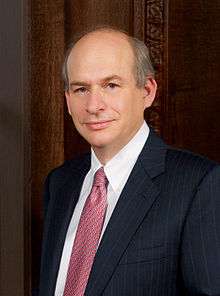David Leebron
David W. Leebron (born 1955) is an American attorney and legal scholar serving as the 7th President of Rice University. He was a professor and dean of Columbia Law School, until he was named president of Rice University on July 1, 2004. Leebron is the first Jewish president of Rice University.
David Leebron | |
|---|---|
 | |
| 7th President of Rice University | |
| Assumed office 2004 | |
| Preceded by | S. Malcolm Gillis |
| Personal details | |
| Born | 1955 (age 64–65) Philadelphia, Pennsylvania, U.S. |
| Spouse(s) | Y. Ping Sun |
| Children | 2 |
| Alma mater | Harvard University (AB, JD) |
| Profession | Professor |
| Website | Office of the President |
| Academic work | |
| Discipline | Law |
| Institutions | |
Early life and education
Born to Carol Leebron and Norman Leebron in 1955[1], David Leebron was raised in Philadelphia, Pennsylvania. An Eagle Scout, Leebron was influenced by a steady stream of exchange students in his house—from Europe, Japan and Mexico—to develop an interest in international affairs. He later traveled to Germany as an exchange student himself and speaks German.[2]
Leebron earned a Bachelors, summa cum laude, in History and Science from Harvard College in 1976, and his JD, magna cum laude, from Harvard Law School in 1979, where he was president of the Harvard Law Review, notably working with the future Supreme Court Chief Justice John Roberts.[2]
Career
Early career
After graduating from Harvard Law, Leebron clerked for Judge Shirley Hufstedler in Los Angeles at the U.S. Ninth Circuit Court of Appeals. He taught as a professor at the UCLA School of Law for a semester. Leebron then entered private practice from 1981 to 1983 as an associate at the New York firm Cleary, Gottlieb, Steen & Hamilton. He then re-entered academia as a law professor at New York University and the director of NYU's International Legal Studies Program from 1983 to 1989. In 1989 he joined the faculty at Columbia Law School, where he became dean in 1996. He became President of Rice University in 2004. As a professor, he taught and published in areas of corporate finance, international economic law, human rights, privacy and torts. He was also a co-author of a textbook on human rights, though most recently has written about problems in international trade law. He is member of the New York State Bar and, currently inactive, the Hawaii and Pennsylvania bars. He is on the American Law Deans Association Board of Directors. He has served on the Association of American Law Schools Committee on Nominations. He is also a member of the American Law Institute (ex officio), the Council on Foreign Relations, the American Society of International Law, the board of directors of the IMAX Corporation and the editorial board of Foundation Press.[2]
Columbia Law School
As Dean of Columbia Law School, Leebron approximately doubled the annual giving and the school's endowment, enhancing financial aid and support for students who enter public service. He was known for recruiting promising junior faculty.[2]
Rice University
Leebron became the 7th President of Rice University[3] on the first of June in 2004.
Under Leebron’s leadership, the campus has added two new residential colleges; the 10-story[4] BioScience Research Collaborative, where scientists and educators from Rice and other Texas Medical Center institutions work together; a new recreation and wellness center; an additional food servery; a central campus pavilion that serves as a meeting and study place; an updated sports arena; a new physics building; and the Public Art Program, a presidential initiative that has added art across campus, although the University suffered a disappointing setback when merger talks between Baylor College of Medicine and Rice stalled.
As president, Leebron has pushed the creation of a vision for the University, called the Vision for the Second Century.[5] Leebron set forth a plan for expansion, calling for opinions from the Rice community.[6] The vision calls for expanding the undergraduate body to around 3800, adding two more residential colleges and expanding the current ones. The new students will mostly come from outside Texas, while the number of students from Texas holds steady at around 1300 students.
In November 2008, Leebron traveled to Iran as part of an academic tour sponsored by the Association of American Universities. On this four-day tour, he visited Sharif University, Iran's top engineering school, where he took part in an open question and answer session with Iranian students.[7] Leebron compared his visit to the opening of relations with China during the 1970s.[8]
Personal life
Leebron married Y. Ping Sun in 1990.[1] Leebron and Sun have two children, Daniel and Mei.[3]
References
- "Y. Ping Sun Wed To David Leebron". The New York Times. 1990-10-08. ISSN 0362-4331. Retrieved 2019-12-21.
- Shepard, Terry (Winter 2004). "Meet David Leebron President-Elect of Rice University". Rice University. Archived from the original on 2004-08-23. Retrieved 2010-08-15.
- "President's Bio | Office of the President | Rice University". president.rice.edu. Retrieved 2019-12-21.
- "About the BRC". Rice University. Archived from the original on August 15, 2017. Retrieved August 15, 2017.
Ten floors of research laboratories and centers
- http://cohesion.rice.edu/administration/presidentsoffice/v2c/V2C_Participate.cfm?CFID=14106490&CFTOKEN=37240967%5B%5D
- "Archived copy". Archived from the original on 2007-09-27. Retrieved 2006-06-27.CS1 maint: archived copy as title (link)
- "U.S. Academics Tour Iran". CBS News. November 18, 2008.
- : http://www.chron.com/disp/story.mpl/editorial/6113846.html
| Academic offices | ||
|---|---|---|
| Preceded by S. Malcolm Gillis |
President of Rice University 2004–present |
Succeeded by Incumbent |
| Preceded by Lance Liebman |
Dean of Columbia Law School 1996–2004 |
Succeeded by David Schizer |